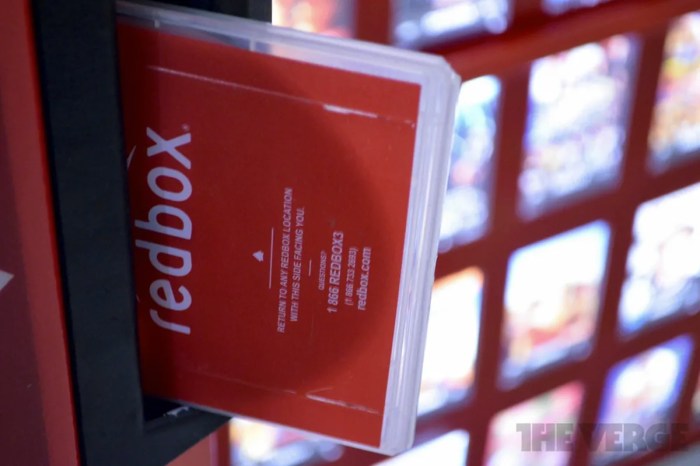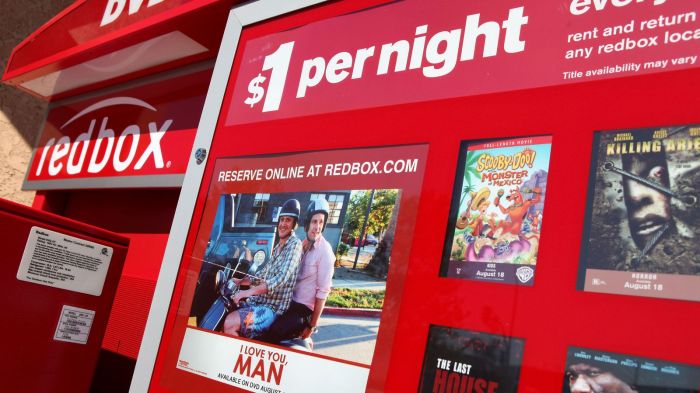Redbox reportedly developing video streaming service again is a move that’s turning heads in the entertainment industry. This isn’t the first time the company has dipped its toes into the streaming pool, with past attempts facing various challenges. However, the current streaming landscape is vastly different, with new players and established giants vying for audience attention. Redbox’s new strategy is expected to capitalize on this shift, aiming to offer a unique proposition that sets it apart from the competition.
This time around, Redbox is looking to leverage its established brand recognition and physical kiosk presence to attract a new generation of streaming subscribers. The company’s success hinges on a well-defined content strategy, a competitive pricing model, and a seamless integration of its streaming service with its existing kiosk business.
Redbox’s History in Streaming: Redbox Reportedly Developing Video Streaming Service Again

Redbox, known for its DVD rental kiosks, has attempted to enter the streaming market several times. While the company has achieved success in the physical media rental space, its streaming endeavors have faced challenges.
Redbox’s Previous Streaming Attempts
Redbox’s foray into streaming began in 2012 with the launch of Redbox Instant, a subscription service offering both on-demand streaming and physical disc rentals. However, Redbox Instant was discontinued in 2015 due to its limited success. In 2017, Redbox introduced a streaming service called Redbox On Demand, which allowed users to rent movies and TV shows for a fee. This service was also discontinued in 2019, with Redbox citing a shift in focus to its core DVD rental business.
Reasons for Redbox’s Initial Foray into Streaming
Redbox’s entry into the streaming market was driven by several factors. The rise of streaming services like Netflix and Hulu presented a significant opportunity for Redbox to expand its reach and cater to a broader audience. The company aimed to leverage its existing brand recognition and customer base to establish a foothold in the digital entertainment space. Additionally, Redbox sought to diversify its revenue streams and mitigate the declining popularity of physical media rentals.
Challenges Faced by Redbox in Streaming, Redbox reportedly developing video streaming service again
Redbox’s streaming ventures faced several challenges. The streaming market was already dominated by established players with vast libraries and extensive marketing budgets. Redbox struggled to compete with these giants, particularly in terms of content acquisition and user acquisition. Additionally, Redbox’s streaming services were often criticized for their limited content selection and clunky user interface.
Factors Contributing to the Success or Failure of Redbox’s Streaming Ventures
Redbox’s streaming attempts were ultimately unsuccessful due to a combination of factors. The company’s late entry into the streaming market put it at a disadvantage against established players. Redbox’s content library was relatively small compared to its competitors, and its user interface was not as user-friendly. Additionally, Redbox’s streaming services were often overshadowed by its core DVD rental business, which continued to be its primary revenue source.
Challenges and Opportunities

Redbox’s foray into streaming faces a landscape saturated with established players, each with substantial resources and loyal audiences. The company’s success hinges on its ability to overcome these challenges and leverage opportunities to carve out a niche in the competitive streaming market.
Challenges
Redbox must address several challenges to establish a successful streaming service.
- Competition: The streaming market is dominated by giants like Netflix, Disney+, and Amazon Prime Video, each with extensive libraries, robust marketing, and dedicated user bases. Redbox must differentiate itself to attract viewers and compete for market share.
- Content Acquisition: Securing high-quality, popular content is crucial for any streaming service. Redbox will need to negotiate licensing agreements with studios and distributors, which can be expensive and competitive.
- Marketing and User Acquisition: Standing out in a crowded market requires effective marketing and user acquisition strategies. Redbox must find ways to reach its target audience and convince them to subscribe to its service.
- Technology and Infrastructure: Developing and maintaining a reliable streaming platform with high-quality video and user experience requires significant technical expertise and investment.
Opportunities
Despite the challenges, Redbox has opportunities to capitalize on:
- Leveraging Existing Brand Recognition: Redbox has a recognizable brand among consumers who are familiar with its physical kiosk model. This pre-existing awareness could translate into a loyal user base for its streaming service.
- Focus on Niche Content: Redbox could differentiate itself by focusing on specific genres or content categories that are underserved by existing streaming services. This could include independent films, foreign language content, or classic movies and television shows.
- Cost-Effective Pricing Strategies: Redbox could offer competitive pricing models, potentially lower than those of its competitors, to attract budget-conscious consumers.
- Partnerships and Integrations: Collaborating with other companies, such as telecommunications providers or retailers, could provide Redbox with access to new markets and audiences.
Long-Term Viability
Redbox’s long-term viability in the streaming market depends on its ability to navigate the challenges and capitalize on the opportunities.
- Strategic Partnerships: Collaborating with studios and distributors to secure exclusive content or create original programming can help Redbox stand out and attract viewers.
- Data-Driven Insights: Utilizing data analytics to understand user preferences and behavior can inform content acquisition, marketing, and platform development decisions.
- Continuous Innovation: Redbox must constantly adapt and innovate to keep pace with the evolving streaming landscape. This could involve exploring new technologies, business models, and content formats.
Whether Redbox can successfully navigate the complexities of the streaming market and carve out a niche for itself remains to be seen. However, the company’s renewed focus on streaming suggests a commitment to adapting to the evolving landscape of entertainment consumption. If Redbox can deliver a compelling streaming experience that resonates with audiences, it could potentially find itself a player to watch in the crowded streaming world.
Redbox, known for its DVD rental kiosks, is reportedly making another attempt at launching a video streaming service. While the details are still under wraps, it’s likely that they’ll need powerful devices to handle the streaming demands. For those looking for a new computer to power their entertainment needs, check out Dell Computer Home: Your Guide to the Latest Models , which offers a comprehensive selection of laptops and desktops.
Whether Redbox’s streaming service will be a success remains to be seen, but it’s clear that they’re determined to make a comeback in the digital entertainment space.